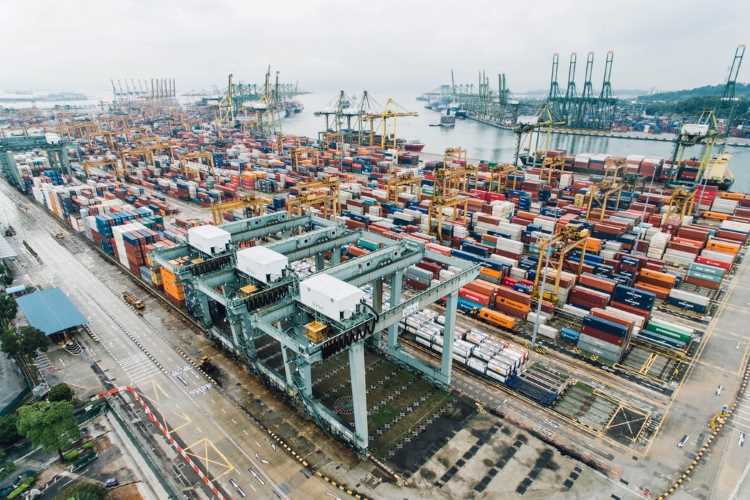
As India looks to accelerate its goal of achieving zero carbon emissions, the ministry of ports, shipping and waterways has introduced the Harit Sagar Green Port Guidelines 2023. The objective of these guidelines is to make India’s ports more environment friendly and sustainable. The launch of Harit Sagar is expected to support the National Green Hydrogen Mission which promotes the use of green hydrogen as a clean energy alternative to fossil fuels. The guidelines encompass various aspects of the mission, including the establishment of green hydrogen facilities, liquefied natural gas (LNG) bunkering, offshore wind energy, and adoption of global Green Reporting Initiative (GRI) standards.
Under the Green Hydrogen Mission, India has set ambitious targets of producing 1 GW of green hydrogen by 2023 and 10 GW by 2030. To achieve these targets, the government has announced several measures to promote the use of green hydrogen. Additionally, the government plans to establish hydrogen clusters in different parts of the country to encourage the adoption of green hydrogen across various sectors.
READ | India’s pharma industry must rebuild its global reputation
What is Harit Sagar initiative
The Harit Sagar initiative focuses on sustainability and environmental stewardship in port operations. This involves reducing greenhouse gas emissions, conserving energy and water, responsible waste management, and protection of local ecosystems. The guidelines for Harit Sagar align with the global green ports agenda which looks to minimise the environmental impact of ports while facilitating trade and economic growth. Currently, ports in San Diego, Singapore, Gothenburg, Vancouver, and Hong Kong have adopted green initiatives.
The Harit Sagar Guidelines 2023 take a nature-first approach. In its release, the ministry says the project aims to consider ecosystem dynamics in port development, operation, and maintenance, with a focus on nature. The objective is to adopt best practices and technologies for green port development and operations, including renewable energy, water conservation, biodiversity protection, and climate resilience.
The guidelines emphasise minimising the impact on the biotic components of the harbour ecosystem during port development. They also emphasise the use of clean and green energy in port operations, the development of port capabilities for storage, handling, and bunkering of greener fuels such as green hydrogen, green ammonia, green methanol, and ethanol. Furthermore, the government plans to establish a rating system to assess and benchmark the environmental performance of ports based on various indicators and parameters. Ports that achieve high standards of environmental excellence and sustainability will be recognised.
Port operations and the environmental cost
Every human activity carries an environmental cost and affects the local communities that depend on nature for their livelihoods. However, often expansion projects disregard the environmental cost and fail to consider the future implications.
Recently, the proposed Vizhinjam International Seaport in Kerala by the Adani Group faced criticism for multiple reasons. Fisherfolk protested against the project for months, claiming that its construction has causing extensive sea erosion, which was detrimental to their livelihoods and dwellings. They demanded an impact study and called for the suspension of the project until the study’s results were available. The port project was expected to have a significant impact on the marine ecosystem, particularly the coral reefs in the area. Environmentalists expressed concerns that dredging for port construction could damage fragile coral reefs that serve as habitats for various marine species.
India’s guidelines for greener ports are a commendable step considering the significant environmental cost associated with port operations and development. One of the most apparent harms is air pollution resulting from emissions from ships, trucks, and other port equipment. These emissions contribute to poor air quality, which can have adverse effects on human health, particularly for individuals living near ports.
Port operations also contribute significantly to water pollution through accidental spills or discharges from ships and port activities. This pollution negatively affects aquatic life, contaminates waterways, and disrupts marine ecosystems. Climate activists have also associated port operations and development with habitat loss and degradation. Coastal habitats, including mangroves, tidal flats, and salt marshes, are frequently destroyed or damaged due to dredging and land reclamation for port construction. These habitats play a crucial role in providing food, shelter, and breeding grounds for marine species, and they serve as natural buffers against coastal storms and erosion.
Moreover, the environmental impact of port operations leads to climate change due to the emission of greenhouse gases, such as carbon dioxide and methane. These gases are generated by the use of fossil fuels to power ships and port equipment. India’s commitments under the Paris Agreement and the Sustainable Development Goals, along with national policies and initiatives like the National Action Plan on Climate Change and the Swachh Bharat Mission, require the country to proactively take steps to mitigate climate change and transition to green energy.
